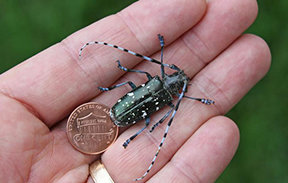DEC seeks swimming-pool owners to study invasive beetle
The state’s Department of Environmental Conservation is looking for swimming-pool owners to participate in the DEC’s annual Asian Longhorned Beetle Swimming Pool Survey during the month of August.
During late summer, Asian longhorned beetles emerge as adults and are most active outside of their host trees. The goal of the survey is to locate infestations of these invasive pests before they cause serious damage to the state’s forests and street trees.
“Most invasive forest pest infestations have been discovered and reported by members of the public, making citizen science a vital tool for protecting our urban and rural forests,” said Commissioner Basil Seggos in a release from the DEC. “Swimming pool monitoring is a simple, economical approach to surveying for Asian longhorned beetles and gives New Yorkers the chance to take an active role in protecting the trees in their yards and communities.”
The DEC is asking swimming pool owners to periodically check pool filters for insects that resemble the beetle and report suspects either by emailing photos to or mailing insects to the DEC’s Forest Health Diagnostics Lab at 108 Game Farm Road, Delmar, NY 12054, Attention: Jessica Cancelliere.
People without swimming pools can help the effort by reporting signs of the beetle in their communities. With more people currently staying at home, the DEC says, it is a perfect opportunity to pay closer attention to yard and neighborhood trees. Invasive Asian long-horned beetles:
— Are about 1.5 inches long, black with white spots, and have black and white antennae;
— Leave perfectly round exit holes about the size of a dime in branches and trunks of host trees; and
— Create sawdust-like material called frass that collects on branches and around the base of trees.
The wood-boring beetles native to Asia were accidentally introduced to the United States through wood-packing materials. These pests attack a variety of hardwoods, including maples, birches, and willows, among others, and have caused the death of hundreds of thousands of trees across the country. The New York State Department of Agriculture and Markets worked diligently to manage infestations in the state, successfully eradicating the beetle from Brooklyn, Staten Island, Manhattan, Islip, and Queens.
The beetle is still actively managed in central Long Island, and there are active infestations in Massachusetts, Ohio, and South Carolina.
